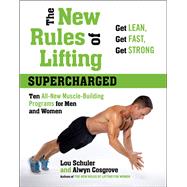
The New copy of this book will include any supplemental materials advertised. Please check the title of the book to determine if it should include any access cards, study guides, lab manuals, CDs, etc.
The Used, Rental and eBook copies of this book are not guaranteed to include any supplemental materials. Typically, only the book itself is included. This is true even if the title states it includes any access cards, study guides, lab manuals, CDs, etc.
In the beginning, Alwyn Cosgrove and I wrote a book calledThe New Rules of Lifting. And it was good. Readers liked it, and they got outstanding results from Alwyn’s training programs. You wouldn’t be reading the fifth book in the series if the first one hadn’t helped lifters like you reach your goals.
But here’s the thing: Most lifters like you haven’t heard of Alwyn, or me, or the NROL series. Millions of men and women lift weights, either at home or in commercial gyms, but it’s hard to see much evidence to suggest they’re getting what they want from it, or what they could get from it.
Instead, I see all the same behaviors and practices that inspired us to launch the series in the first place.
I see paunchy middle-aged men block the dumbbell rack as they grind through set after set of every biceps exercise they remember fromFlexmagazine circa 1995, while avoiding the exercises that use the body’s biggest muscles in coordinated action, the movements that would do the most to build muscle, burn fat, and turn back the clock to the days when they looked more like a page fromMen’s HealththanCigar Aficionado.
I see apparently healthy women doing the beneficial exercises the men avoid—the squats, deadlifts, and rows—but with weights that wouldn’t challenge someone twice their age, with half their strength.
I see young lifters doing exercises that will turn them into old lifters, the moves most likely to cause injury and least likely to offer much benefit. I see older lifters doing half-baked versions of programs designed for young athletes or bodybuilders, only without any apparent sense of the mechanisms that would make such a program work.
It’s like they’ve all gotten the first half of the memo about the importance of strength training for health, fitness, and appearance. But somehow the rest of the memo—the part that explains what you need to do to get the results you want—got deleted. So, in a way, the NROL series is the second half of that memo.
Take the first New Rule of Lifting: “The best muscle-building exercises are the ones that use your muscles the way they’re designed to work.”
Or the third: “To build size, you must build strength.”
Or the twenty-third: “Results come from hard work.”
Or the forty-third: “You can’t protect your spine by doing exercises that damage it.”
Or the sixty-third: “You’re not a kid anymore. Don’t train like one.”
See what I mean?
The readers who found and implemented the originalNew Rules of Lifting(along with the ones who readNROL for Women, for Abs, andfor Life) know what it means totrain. They know how to lift in a way that allows them to get progressively stronger, to add more muscle, to reduce fat, to workwiththeir bodies rather thanagainstthem. They’re the ones who walk past the machines in their health club and pick up free weights. They’re the ones who get stronger over time, at any age, despite roadblocks or limitations. They’re the ones who look like they know what they’re doing. They move with purpose. They sweat, they grimace, and every now and then they actually grunt.
Does that describe you?
If so, great. You’re either a satisfied NROL reader, coming back for the newest information and most up-to-date programs, or you’re a target reader, someone who’s ready to do what it takes to get leaner, stronger, and more athletic.
Not you? Pull up a chair, and let’s talk.